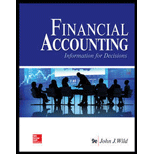
1.
Introduction:
Bad debt is an amount that a company fails to receive when the debtors or become insolvent.
To prepare:
Bad debts are 1% of total revenue- Bad debts are 2% of accounts receivables.
2.
Introduction: Accounts receivable are legitimately enforceable returns or payments which the organization will get from its clients who have bought its merchandise and services on credit. It is merely a promise to repay the vendor.
Bad debt is an amount that a company fails to receive when the debtors or become insolvent.
To prepare: Adjusting entry for bad debts
3.
Introduction: Accounts receivable are legitimately enforceable returns or payments which the organization will get from its clients who have bought its merchandise and services on credit. It is merely a promise to repay the vendor.
Bad debt is an amount that a company fails to receive when the debtors or become insolvent.
To explain: If direct write off method is better or allowance method for computing bad debts is better.
Want to see the full answer?
Check out a sample textbook solution
Chapter 7 Solutions
Loose Leaf for Financial Accounting: Information for Decisions

 AccountingAccountingISBN:9781337272094Author:WARREN, Carl S., Reeve, James M., Duchac, Jonathan E.Publisher:Cengage Learning,
AccountingAccountingISBN:9781337272094Author:WARREN, Carl S., Reeve, James M., Duchac, Jonathan E.Publisher:Cengage Learning, Accounting Information SystemsAccountingISBN:9781337619202Author:Hall, James A.Publisher:Cengage Learning,
Accounting Information SystemsAccountingISBN:9781337619202Author:Hall, James A.Publisher:Cengage Learning, Horngren's Cost Accounting: A Managerial Emphasis...AccountingISBN:9780134475585Author:Srikant M. Datar, Madhav V. RajanPublisher:PEARSON
Horngren's Cost Accounting: A Managerial Emphasis...AccountingISBN:9780134475585Author:Srikant M. Datar, Madhav V. RajanPublisher:PEARSON Intermediate AccountingAccountingISBN:9781259722660Author:J. David Spiceland, Mark W. Nelson, Wayne M ThomasPublisher:McGraw-Hill Education
Intermediate AccountingAccountingISBN:9781259722660Author:J. David Spiceland, Mark W. Nelson, Wayne M ThomasPublisher:McGraw-Hill Education Financial and Managerial AccountingAccountingISBN:9781259726705Author:John J Wild, Ken W. Shaw, Barbara Chiappetta Fundamental Accounting PrinciplesPublisher:McGraw-Hill Education
Financial and Managerial AccountingAccountingISBN:9781259726705Author:John J Wild, Ken W. Shaw, Barbara Chiappetta Fundamental Accounting PrinciplesPublisher:McGraw-Hill Education





